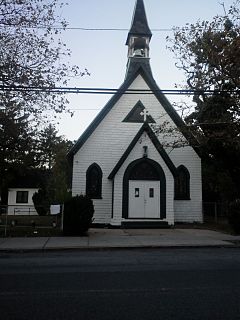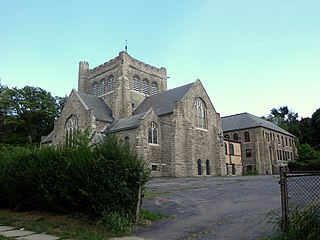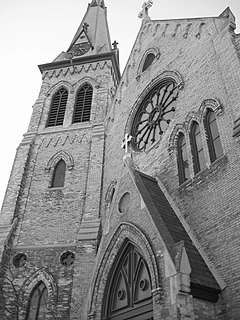
The Cathedral Church of All Saints is the bishop's church of the Episcopal Diocese of Milwaukee, in Milwaukee, Wisconsin, USA. The current parish is a descendant of a small mission by the Right Reverend Jackson Kemper. It is located in Milwaukee's downtown Yankee Hill neighborhood.
"Christ Episcopal Church" may refer to the following similarly named churches or parishes in the United States:

St. Paul's Episcopal Church is a Richardsonian Romanesque-styled church built in 1882 in Milwaukee, Wisconsin in the Episcopal Diocese of Milwaukee. Noted for its Tiffany windows, it is listed on the National Register of Historic Places and is a designated Milwaukee Landmark.

Christ Church Cathedral, built in 1916 to replace the earlier 1874 building, is the Episcopal cathedral in Eau Claire, Wisconsin. It is the mother church for the Episcopal Diocese of Eau Claire, the see of which is located in Eau Claire. The cathedral and parish house were added to the National Register of Historical Places in 1982.

Christ Episcopal Church is a historic Episcopal church located in La Crosse, Wisconsin in the Episcopal Diocese of Eau Claire. In 1985, Christ Church was added to the National Register of Historic Places.

Grace Episcopal Church located at 1011 North 7th Street in Sheboygan, Wisconsin, is an Anglo-Catholic parish of the Episcopal Church, part of the Diocese of Fond du Lac.

Christ Church, officially The Parish of Christ Church, Hyde Park is a historic church building built in 1893 at 1220 River Road in Hyde Park, Massachusetts, a neighborhood of Boston. It is a parish of the Episcopal Diocese of Massachusetts.

Trinity Episcopal Church is a historic Episcopal church complex located at Buffalo in Erie County, New York. The oldest part of the complex was built in 1869 as the Gothic Revival style Christ Chapel; it was later redesigned in 1913. The main church was constructed in 1884–1886 in the Victorian Gothic style and features stained glass windows designed by John LaFarge and Tiffany studios. The parish house, designed by Cram, Goodhue & Ferguson, was constructed in 1905.

St. Ann's Church, also known as St. Ann's Church of Morrisania, is a historic Episcopal church in Mott Haven, the South Bronx, New York City.

Trinity Chapel, also known as St. John's Church and Beth-El Temple Church of God in Christ, is a historic Episcopal church at 1874 Mott Avenue in Far Rockaway, Queens, New York. It was built in 1858 to the design of architect Richard Upjohn (1802–1878). It is a frame Gothic Revival style chapel on a brick foundation and three bays wide by five bays long. It has a steeply pitched roof and sided in wood shingles. Atop the roof is a wooden belfry with steeply pitched pyramidal roof. It was founded as Trinity Chapel as a mission of Trinity Church in Hewlett, New York. Its name was changed to St. John's of Far Rockaway in 1881 when it became an independent parish. St. John's merged with Trinity Church in 1974 and the building was sold the following year to Beth-El Temple Church of God in Christ.

Christ Church New Brighton (Episcopal) is a historic Episcopal church complex at 76 Franklin Avenue in New Brighton, Staten Island, New York. The complex consists of a Late Victorian Gothic church (1904) and parish hall, connected to the church by an enclosed cloister, and a Tudor-style rectory.

The Christ Church Chapel is a religious building located at 61 Grosse Pointe Blvd. in Grosse Pointe Farms, Michigan. It is also known as the Christ Church Grosse Pointe or the Christ Episcopal Church. It was designated a Michigan State Historic Site in 1992 and listed on the National Register of Historic Places in 1993.

Fletcher Chapel, also known as Church of God and the Saints of Christ Church, is a historic chapel located in Northwest, Washington, D.C.

The 27th Street Historic District is a historic district in the South Los Angeles area of Los Angeles, California. The district was listed on the National Register of Historic Places in 2009 as part of the multiple property submission for African Americans in Los Angeles.

First Congregational Church of Austin, also known as Greater Holy Temple of God in Christ, is a historic church at 5701 West Midway Place in Chicago, Illinois. The church was built in 1905 for a Congregational assembly; it was later used by Seventh-Day Adventist, Roman Catholic, and Church of God in Christ congregations. Architect William Eugene Drummond, a student of Frank Lloyd Wright, designed the church in the Prairie School style; it is an unusual example of a Prairie School church and was influenced by Wright's Unity Temple. The one-story building consists of a tall central section with massive piers and a smaller section to either side. The entrance is recessed in the base of the central section; the doorway features lintels and posts that continue the building's rectilinear emphasis. Leaded glass windows are recessed in the spaces between the central section's piers.

St. Luke's Episcopal Church, Chapel, Guildhall, and Rectory is a historic church complex in Racine, Wisconsin. It was added to the National Register of Historic Places in 1979 for its architectural significance.

Kemper Hall is the complex of an Episcopal college in Kenosha, Wisconsin, United States which began with an Italianate mansion and was expanded with various wings and buildings in Gothic Revival style. It was added to the National Register of Historic Places in 1976.
Christ Church was a historic Episcopal church located at Norfolk, Virginia. It was built in 1828, and was a one-story, temple form church in the Greek Revival style. It was fronted by a distyle portico with two unfluted Greek Doric order columns. It measured approximately 64 feet by 96 feet, and featured a cupola with octagonal belfry. The congregations roots can be traced back to 1637. In 1798, the congregation of Borough Church split into two factions, with the other being Saint Paul's Episcopal Church. Christ Church merged their congregation with St. Luke's in 1910, and the building housed a Greek Orthodox congregation until 1955. It was demolished in January 1973.

Elmwood Historic District–West is a national historic district located at Buffalo, Erie County, New York. The district encompasses 1,971 contributing buildings, 4 contributing structures, and 13 contributing objects in the Elmwood Village neighborhood of Buffalo. It is built around the Buffalo Parks and Parkways system bounded on the north by Delaware Park, Forest Lawn Cemetery, and the former Buffalo State Asylum, on the south by the Allentown Historic District, and on the east by the Elmwood Historic District–East. This predominantly residential district developed between about 1867 and 1941, and includes notable examples of Queen Anne, Shingle Style, Colonial Revival, Tudor Revival, and American Craftsman style architecture. The district contains one of the most intact collections of built resources from turn of the 20th century in the city of Buffalo and western New York State. Located in the district are six previously listed contributing resources including the Richmond Avenue Methodist-Episcopal Church and the Buffalo Tennis and Squash Club. Other notable building include the H.C. Gerber House (1908), the Fred Dullard House (1910), the William H. Scott House (1904), St. John's-Grace Episcopal Church designed by Bertram Grosvenor Goodhue (1925–26), Davidson House (1885), former Jehle Grocery Store and Residence, St. Luke's Episcopal Church, Temple Beth El, Richmond Avenue Church of Christ (now Bryant Parish Condominiums, and Pilgrim-St. Luke's United Church of Christ.

The Byron A. Beeson House, also known as Mission Temple Academy, is a historic building located in Des Moines, Iowa, United States. Built c. 1890, the 2½-story structure features balloon frame construction, a complex roof system, and wrap-around front porch. Its flared cornice is considered unusual. It was originally a single-family dwelling that later became and education facility associated with the Church of God in Christ. It is also associated with Byron A. Beeson who served as Treasurer of Iowa from 1891 to 1895, and as Adjutant General of the Iowa National Guard around the same the same time. The house's significance is derived from its location in suburban North Des Moines and its complex roof system. It was listed on the National Register of Historic Places in 1996. A stable along the alley behind the house shares the historic designation.





















